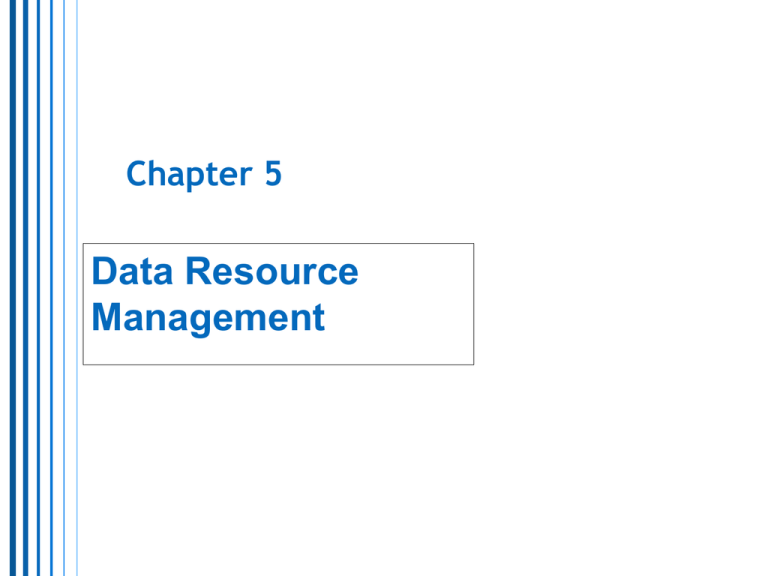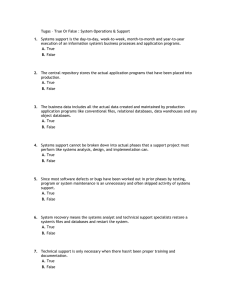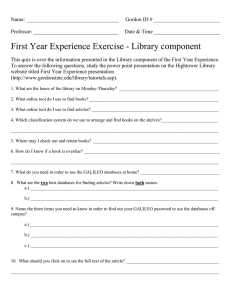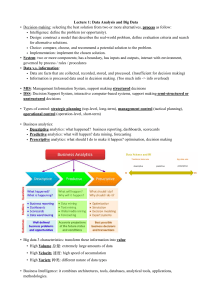Data Resource Management Chapter 5
advertisement

Chapter 5 Data Resource Management I. Why do organizations store data? Data resources must be structured and organized in some logical manner so they can be accessed, processed, retrieved, and managed easily 2 Traditional File Processing Problems 1. Data Redundancy 2. Lack of data Integration 3. Data Dependence – data and programs “tightly coupled” 4. Lack of Data Integrity (Standardization) 3 II. Fundamental Data Concepts Character – the most basic logical data element that can be observed, a single alpha or numeric or other symbol, represented by one byte Field – a grouping of related characters, as a last name or a salary, represents an attribute of some entity General Purpose Application Programs – perform common information processing jobs for end users 4 II. Fundamental Data Concepts Record – a grouping of attributes that describe an entity File – a group of related data records Database – a collection of logically related data elements 5 II. Fundamental Data Concepts 6 III. Database Structures (Models) Hierarchical Structure – treelike structure of oneto-many parent-child relationships (each child can have only one parent) Network Structure – similar to hierarchical but allows many-to-many relationships (a child record can have more than one parent) Relational Structure – the most widely used database model today; data is represented as a series of two-dimensional tables called Relations; each column is a named attribute of the entity, each row is an unnamed instance of that entity 7 IV. Database Development Database Administrator (DBA) – controls development and administration of the database Data Definition Language (DDL) – used to specify the contents, relationships, and structure of the database Data Dictionary – directory containing the metadata Metadata – data about the data 8 I. Data Resource Management Types of Databases Used by Organizations and End-Users 9 II. Types of Databases Operational Databases – store detailed data to support business processes and operations Distributed Databases – many organizations distribute their databases over multiple locations Replication – complex process of updating distributed data Duplication – simplified method of updating distributed data 10 II. Types of Databases External Databases – outside the firm, free or fee-based Hypermedia Databases – hyperlinked pages of multimedia 11 Data Warehouses/Data Mart and Data Mining 12 III. Data Warehouses and Data Mining Data Warehouse – stores data extracted from other databases Data Mart – subset of a data warehouse focusing on a single topic, customer, product, etc. Data Mining – analyzing a data warehouse to reveal hidden patterns and trends 13 III. Data Warehouses and Data Mining Components of a Data Warehouse System 14 Natural Language versus SQL 15 Graphical Query 16 Source: Courtesy of Microsoft Corp. IV. Database Development Entity Relationship Diagram (without details) 17 Relational Database Structure 18 ERDs to create in class • Supplier (Manufacturer, Products) • Registration System (Student, Course, Registration) • Appointment (Doctor, Patient, Appointment) • Bank (Customer, Account, Transaction) • Library (Borrower, Checkout, Book) 19






